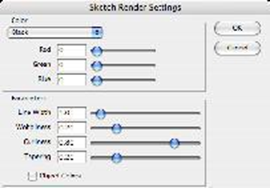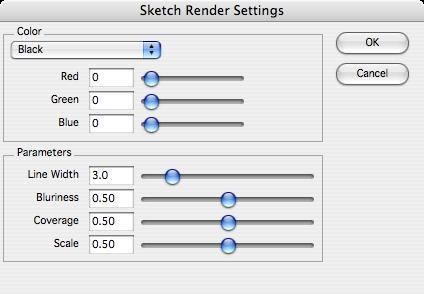Sketch Rendering
Sketch Renderings are designed to support rendering at the conceptual design stage or for stylized presentations. The supported styles include:
- cartoon
- colour wash contour
- hand drawn hatch
- ink print
- lines and shadow mosaic
- oil painting rough pencil soft pencil stipple
The Sketch Rendering tool activates the different tools on the Prompt window.

Cartoon
A classic cartoon style effect, where silhouette and boundary edges are picked out with bold lines and colors are somewhat simplified and stylized. It is possible to control the color and width of the lines in the Options dialog. The colors painted between the lines will depend on the materials, but are quite flat (i.e., very little tonal change as you look across a surface) to reflect the simplified palette employed by cartoon artists. This style uses hidden-line.
No RenderCartoon Render

Options
Click the Options button to access the Sketch Render Settings dialog box. Here, you can control the color and line width.

Colour Wash
As in the cartoon style, edges are picked out with lines, and the spaces in between are filled with simplified color. In the case of colour wash, however, the colors are less cartoon-like, and can be washed-out to look much more pastel and less intense. The width and color of the lines is still specified via the options dialog, but it is also possible to control the degree of color variation across objects, and the degree to which the colors are washed. This style uses hidden-line.

No RenderColour Wash Render
Options
Click the Options button to access the Sketch Render Settings dialog box. Here, you can control the color, line width, and other parameters associated with the style.

Contour
Creates a very “painterly” effect, with strokes and swirls of color which reflect and represent the orientation of the underlying geometry. The effect may also be interpreted as being akin to using colored pencils to shade the image (with the direction of the pencil strokes matching the underlying geometry at all times). This style does not use hidden-line.

No RenderContour Render
Options
The length and density of each stroke can be edited.
A low value for the line or stroke length will lend a finer, more detailed appearance to the final image. A low value for the density of the strokes or lines will result in more of the background color or paper color, showing through. Therefore, a background of either paper or canvas, certainly a light color, is likely to be more appropriate in many cases.
Normally, the colors of the strokes would be taken from the color of the objects being represented however, this can be changed so that a particular line color is used; simply uncheck the Object Colors checkbox.
Hand Drawn
This is a style in which objects are rendered using lines, but where the lines appear to be made up of individual strokes. Note that the current background is interpreted as being the “paper” or “canvas” onto which the lines are drawn, so it is important to choose a color for the lines which will be visible against your particular background. This style uses hidden-line.

No RenderHand Drawn Render
Options
The color and width of the lines can be controlled in the Sketch Render Settings dialog, as can the degree from which each stroke varies from true, the smoothness of the strokes, and also the degree of taper from the start to the end of the stroke. All of these factors can be controlled via shader arguments, allowing the effect to be suited to different models at different resolutions, with different drawing styles or pencils or pens.

Hatch
This style produces an effect similar to a shaded pencil drawing, in either monochrome or color. The image is made up of a series of pencil “strokes” all in a similar orientation (short strokes, from bottom left to top right in direction, as though a right handed artist were shading roughly with a pencil). All of the strokes are to provide shading - no lines are drawn. This style does not use hidden-line.

No RenderHatch Render
Options
The Sketch Render Settings dialog offers controls for the color, width, length, and density of the pencil strokes, as well as how straight or curved the strokes appear.
A low value for the density of strokes will result in a very sparse looking image, with plenty of “paper” showing through, while a higher density will result in dark regions being almost completely shaded (note that lighter regions will still show up as the paper color or background).

Ink Print
This style can be thought of as almost a photographic negative of other line-based styles. The entire image is rendered in a given “ink color”, save for the lines, which are simply left as “gaps” in the ink color. This style uses hidden-line.

No RenderInk Print Render
Options
The Sketch Render Settings dialog allows you to specify the ink color and the size of the gaps.
Lines and Shadow
This style combines a simple line representation of geometric objects with a (monochrome) shaded effect for areas in shadow. The result is very much like a pencil drawing where edges and shape are captured first using lines and then some shading work is done with the edge of the pencil. This style uses hidden-line.

No RenderLine & Shadow Render
Options
The color and line width can be controlled on the Sketch Render Settings dialog.

Mosaic
This has the effect of rendering the image as though it were constructed as a mosaic of small colored tiles. If desired, it is possible to leave areas of exposed background in the scene untitled, in other words only to produce a mosaic pattern for the geometry, then apply some other pattern or image for the background. This style does not use hidden-line.
Options
The size and shape of the tiles can be controlled on the Sketch Render Settings dialog, as can the size and color of the gaps between the tiles. It is also possible to use the background color as the color for the gaps between the tiles or to blend a background and a given gap color


Oil Painting
This style creates an effect reminiscent of some impressionist painters, with individual blobs of paint (which could be brush or palette-knife strokes) of a single color applied across the canvas, so that the overall image only resolves itself if you view from far enough away.
The brush strokes are always slightly circular, roughly C-shaped marks. The shape of the strokes is not affected by the orientation, proximity or color of the underlying geometry that the stroke represents.
The effect is impressive with image scenes that have a strong shape and do not rely too heavily on detail to convey their meaning. Scale, and how the detail relates to scale, is quite important; if the size of the brush strokes means that important detail is lost then the results may be unimpressive. This style does not use hidden-line.

Options
Using the Sketch Render Settings dialog, it is possible to alter the size of the individual marks, and the number that appear in the whole image (it is important to choose values for these parameters such that any detail required in the final image will be resolved, without losing the ‘painterly’ effect).
It is also possible to control the degree to which the marks obscure the background color. The entire canvas can be filled with marks that overlap or there can be gaps between the marks, creating a lighter feel.
Rough Pencil
Rough pencil produces an effect as though an artist had gone over each line several times, each with a small margin of error. The style is well suited to situations where a design is still quite tentative, as the effect is of a very rough, quick pencil sketch. This style uses hidden-line.


No RenderRough Pencil Render
Options
The color, width, and number of lines can be controlled on the Sketch Render Settings dialog, as can the ‘wobbliness’ of lines (how far each line can deviate from true) and the ‘curliness’ of lines (how far from straight or jagged each line is).

Soft Pencil
The soft pencil style mimics the effect of a pencil drawing done with a soft pencil, so that in some places the pencil hardly leaves a mark. This style uses hidden-line.

No RenderSoft Pencil Render
Options
The color and width of the pencil line, as well as the line sharpness, can be adjusted on the Sketch Render Settings dialog. It is also possible to control the extent to which the pencil line appears to fade in and out as the pencil traveled over the paper.

Stipple
This effect causes the image to be rendered as a series of irregular dots or stipples. The effect is similar to how photographs are reproduced in newsprint, only more pronounced. By default the stipples are all rendered in one color (black by default, but the ‘ink’ color can be altered). This style does not use hidden-line.

No RenderStipple Render
Options
Using Stipple, a color can be specified or you can choose to use the color of the underlying geometry for each stipple. If this option is chosen, the effect becomes reminiscent of the ‘pointillism’ school of impressionistic painting, where scenes were rendered by points of color or light. You can also adjust the amount of dots that appear.
